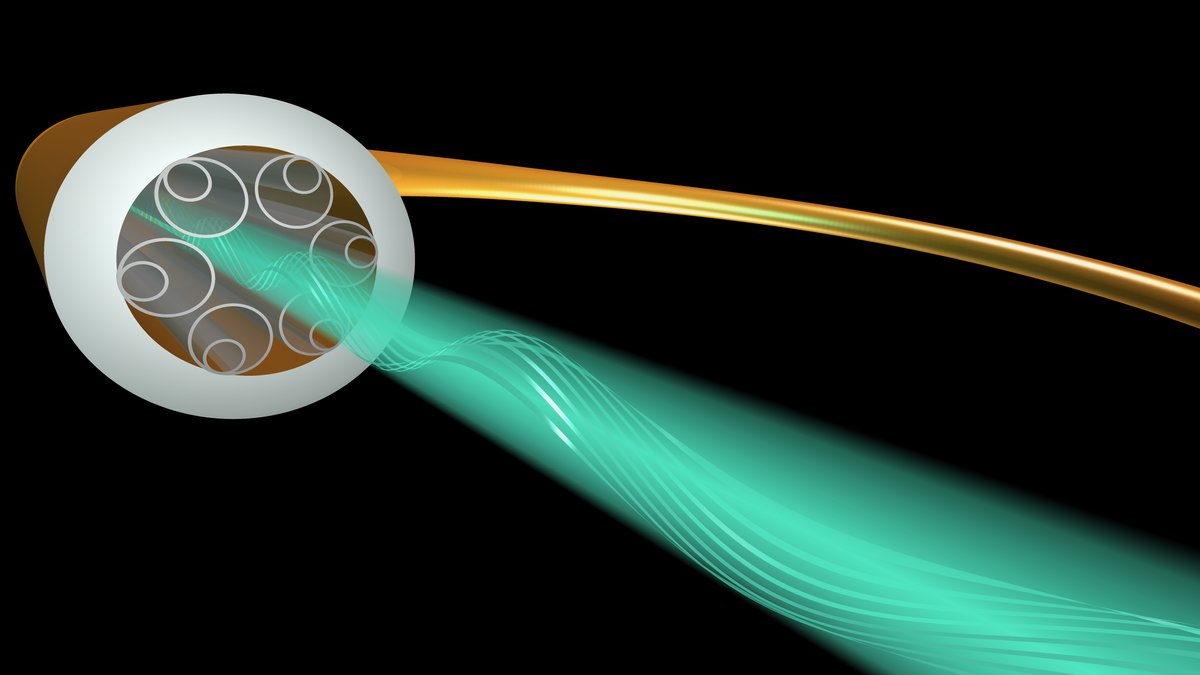Recent reductions in loss of hollow-core fibers make them attractive for communication applications. Now a hollow-core fiber described in Nature Photonics on 30 May can transport a kilowatt of laser power up to a kilometer away. The development marks a big step for precision machining that requires high-power laser beams.
Standard optical fibers—whether they’re being used for communications or machining—work by trapping light aimed along their length inside a solid glass core surrounded by a glass cladding with a lower refractive index. Any light that hits the cladding boundary is perfectly reflected into the core through total internal reflection. Light traveling through the fiber is lost only by the scattering and absorption of photons.
If the core is pure silicon dioxide, the loss at wavelengths near 1.55 micrometers—the wavelength of choice for fiber-optic signals—is less than 0.2 decibels per kilometer. In other words, 1 percent of light entering a 100-kilometer length of such fiber emerges from the other end, which is still good enough for long-distance communications.
In contrast, hollow-core fibers are made of glass cladding surrounding an air-filled center. The refractive index of the surrounding glass tube is higher than the refractive index of air, which means that normally, the light in a hollow-core fiber would leak from the air into the glass. The trick to preventing this lies in shaping delicate structures along the interior of the glass tube that curve away from the wavefront of the light.
To do that, Francesco Poletti’s group at the Optoelectronics Research Centre at the University of Southampton, in England, designed what they call nested antiresonant nodeless fiber (NANF). These fibers have parallel glass tubes spaced around the inside of the air-filled core, with another tube nested inside each of those tubes. The tube surfaces are curved away from the center of the hollow core, to avoid resonances that could let light leak into the glass. The tubes also do not touch on their sides, preventing nodes that could also let light leak out of the hollow core.
Using the NANF design, the research group made a hollow-core fiber with loss of only 0.174 decibels per kilometer at 1.55 micrometers. They announced their achievement in March at the Optical Fiber Communications Conference (The conference is cosponsored by the IEEE). That’s getting close to the lowest loss ever reached in solid-core fibers. Beyond that, its key attraction for communications is that light travels at 300,000 kilometers per second through the hollow core—50 percent faster than light’s speed in glass, which reduces latency.
Optical fiber is also useful in laser machining. Precision machining requires concentrating laser power to very high levels on very small spots. However, increasing the laser’s power also increases electromagnetic fields to extremely high levels that can bend the path light takes. At high enough levels, the power can damage the fiber’s glass itself. The further the light travels through the glass, the stronger the resulting nonlinear effects, and the larger the problem. High-power fiber-based lasers can concentrate light into a tightly focused beam only 10–16 micrometers wide, but after passing through just a few tens of meters of glass fiber, a kilowatt beam is too distorted to perform fine machining.
The advantage of NANF hollow-core fibers is that they can direct the light away from the glass and into the vacant regions in the hollow core, avoiding the nonlinear effects that could break up the beam. In Nature Photonics, Poletti and colleagues describe a design optimized for power transmission that couples 95 percent of a kilowatt of laser light into the fiber. And the design concentrates it so well in the air-filled core that only between one ten-thousandth to one hundred-thousandth of the light travels through the glass in a kilometer length of fiber. The power-transmission fiber’s loss is 0.74 dB/km, higher than that of the best hollow-core fibers, but attenuation is not the critical factor, and the ytterbium laser operates at around 1.07 micrometers, where loss is higher than at 1.55 micrometers. The results “show the extreme potential” of hollow-core fibers, says Christian Röhrer of the University of Stuttgart, who was not involved in the study. “The important thing is that they are high-power suitable and do not get destroyed by the [optical power] in the core overlapping with the surrounding glass structure.” With robots used to move the flexible beam-delivery fiber, he adds, “basically all applications can benefit from the delivery of high-power beams over long distances.“
Jeff Hecht writes about lasers, optics, fiber optics, electronics, and communications. Trained in engineering and a life senior member of IEEE, he enjoys figuring out how laser, optical, and electronic systems work and explaining their applications and challenges. At the moment, he’s exploring the challenges of integrating lidars, cameras, and other sensing systems with artificial intelligence in self-driving cars. He has chronicled the histories of laser weapons and fiber-optic communications and written tutorial books on lasers and fiber optics.



